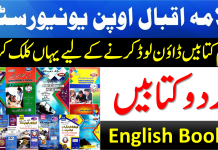Past Papers
- Latest Jobs
- Latest Admissions
- Latest Government Jobs
- Latest Private Jobs
- Computer Science and IT
- Engineering and Technology
- Medical and Health Sciences

Research Methods in Education (Professional) Code No. 8604 Autumn 2021 Past Papers | AIOU
- AIOU Past Papers »
- B.Ed (1.5 Years) »
- Research Methods in Education (Professional) (8604) »
- Autumn 2021
- Name Research Methods in Education (Professional)
- Code Number 8604
- Year/Semester Autumn 2021
Research Methods in Education (Professional) Other Helping Material and Past Papers
- Research Methods in Education (Professional) Spring 2022
- Research Methods in Education (Professional) Autumn 2021
- Research Methods in Education (Professional) Spring 2019
- Research Methods in Education (Professional) Spring 2018
- Research Methods in Education (Professional) Autumn 2017
- Research Methods in Education (Professional) Spring 2017
- Research Methods in Education (Professional) Autumn 2016
Explore Other Subjects
- Curriculum Development (Foundation) (8603)
- Educational Leadership and Management (Professional) (8605)
- Educational Assessment and Evaluation (Professional) (8602)
- Citizenship Education and Community Engagement (8606)
- General Methods of Teaching (Professional) (8601)
- Teaching Practice I (Professional) (8607)
- Teaching Practice II (Professional) (8608)
- Philosophy of Education (Foundation) (8609)
Related Articles

Contacs us (query/feedback)
- Tips & Tricks
- AIOU Admission Amendments
- AIOU Admission Confirmation
- AIOU Assignments Question Papers
- AIOU CT Books
- AIOU Diploma in Education Books
- AIOU FA Books
- AIOU Functional Non Credit Certificate Courses Books
- AIOU M.A ARABIC Books
- AIOU M.A E.P.M Books
- AIOU M.A Education Books
- AIOU M.A HISTORY Books
- AIOU M.A Islamic Studies Books
- AIOU M.A Library Science Books
- AIOU M.A TEFL DIP Books
- AIOU M.A Urdu Books
- AIOU M.Ed Books
- AIOU M.PHIL Books
- AIOU MA Special Education Books
- AIOU Matric Books
- AIOU MBA Urdu Books
- AIOU MPA Executive Books
- AIOU MSc Books
- AIOU PHD Books
- AIOU Postgraduate Diploma Books
- AIOU PTC Books
- AIOU Short Term Educational Programmes Books
- AIOU Degree Verification System
- UOG Past Papers
- UOG Past Papers BA
- UOG Past Papers BCom
- UOG Past Papers BSc
- UOG Past Papers ICom
- UOG Past Papers MA
- UOG Past Papers MCom
- UOG Past Papers MSc
- UOG Syllabus for Private and Regular Students
- UOG Syllabus Botany
- UOG Syllabus Chemistry
- UOG Syllabus Commerce
- UOG Syllabus Computer Science
- UOG Syllabus Economics
- UOG Syllabus Education
- UOG Syllabus English
- UOG Syllabus Fine Arts
- UOG Syllabus Geography
- UOG Syllabus History
- UOG Syllabus International Relation
- UOG Syllabus Islamic Study
- UOG Syllabus Mathematics
- UOG Syllabus Pak Study
- UOG Syllabus Physical Education
- UOG Syllabus Physics
- UOG Syllabus Political Science
- UOG Syllabus Psychology
- UOG Syllabus Sociology
- UOG Syllabus Statistics
- UOG Syllabus Urdu
- PU Past Papers
- PU Past Papers B.B.A
- PU Past Papers B.Com
- PU Past Papers B.S Applied Geology
- PU Past Papers B.S.Ed
- PU Past Papers Doctor of Pharmacy (Pharm.D)
- PU Past Papers LL.B
- PU Past Papers M.A./ M.Sc
- PU Past Papers M.B.A
- Conversation
- English Grammar
- English Speaking
- Accounting MCQ
- Auditing Mcqs
- Chemical Engineering MCQs
- Civil Engineering MCQ
- Electrical Engineering MCQs
- Finance MCQs
- Human Resource Management Mcqs
- Marketing Management MCQ
- Mechanical Engineering MCQs
- Test Preparation Biology
- Test Preparation BPSC
- Test Preparation Chemistry
- Test Preparation Computer
- Test Preparation Current Affairs
- Test Preparation English
- Test Preparation English Grammar
- Test Preparation FPSC
- Test Preparation General Knowledge
- Test Preparation Islamic Studies
- Test Preparation KPPSC
- Test Preparation Math
- Test Preparation NTS
- Test Preparation Pakistan Studies
- Test Preparation Pedagogy
- Test Preparation Physics
- Test Preparation PPSC
- Test Preparation SPSC
- Test Preparation Urdu
- UOG Registrations
- UOG Admissions
- UOG Date Sheets
- UOG Results
- UOG Syllabus Zoology

AIOU Past Papers BA BCOM Associate Degree

Allama Iqbal Open University AIOU Past Papers

AIOU Code 405 Iqbaliat Solved Assignments Spring And Autumn

Change Exam Center AIOU

UOG PU UOS M.A Urdu Part 1 And Part 2 Solved…

M.A Urdu Guide PDF Download

University of Sargodha UOS University of Gujrat UOG Solved Objective Questions…


Download Roll No Slip for BA BSc Associate Degree Part II…

University of Punjab Past Papers of Last 5 Years MA MSC…
Aiou bachelor ba bcom solved assignments.

AIOU Books Download PDF Part 5

AIOU Solved Notes Code 9442 Office Automation PDF

AIOU Solved Notes Code 9441 Anthropology PDF

Important Computer MCQs From Basic To Advance

100 Physics Questions and Answers

FIA Test Preparation Books PDF Download Free For All Posts

Marketing Management MCQ With Answers
Aiou code 8604 research methods in education solved assignments spring and autumn.
AIOU Code 8604 Research Methods in Education Solved Assignments Spring And Autumn Allama Iqbal Open University (AIOU) performs an important position in offering accessible and high-quality training to learners throughout Pakistan. One of many notable programs provided by AIOU is Code 8604: Research Methods in Education. This course is designed to equip University students with the required abilities to conduct significant analysis within the area of training. As a part of the tutorial journey, University students are required to finish assignments, and acquiring solved assignments for Code 8604 can vastly improve the training expertise.
Code 8604: Research Methods in Education:
Code 8604 is a complete course that delves into the varied analysis methodologies relevant to the sphere of training. The target is to empower University students with the data and abilities required to design, conduct, and analyze analysis in academic settings. The course covers matters comparable to analysis design, knowledge assortment strategies, statistical evaluation, and moral concerns in academic analysis.
Download AIOU Solved Assignments Free PDF
Note: If you want more solved assignments of all other codes Click Here
علامہ اقبال اوپن یونیورسٹی کی ہاتھ سے لکھی ہوِئی ،پی ڈ ی ایف اور ورڈ فائل حل شدہ مشقیں حاصل کرنے کے لیے رابطہ کریں
Download AIOU Text Books Key Books Guess Papers And Notes
Download aiou past papers last five years old papers, significance of solved assignments:.
Solved assignments are an integral part of the training course, permitting University students to use theoretical ideas in real-world situations. Nevertheless, tackling assignments, particularly in research-intensive programs like Code 8604, might be difficult. That is the place where solved assignments come into play.
Solved assignments present University students with a useful resource to know the intricacies of analysis strategies and their utility in training. By reviewing solved assignments, University students can grasp the right methodology, construction, and strategy for answering questions. This not only facilitates a greater understanding of the course content material but also enhances the standard of the assignments submitted.
Most Popular
- AIOU Solved Past Papers 1019
- Allama Iqbal Open University AIOU 880
- AIOU Solved Guess Papers and Notes 358
- Past Papers 337
- Education 195
- Spoken English 145
- University of the Punjab 118
- PU Past Papers 113
- Test Preparation 106
- English Speaking 83
- AIOU Guess Papers 78
- Privacy Policy

IMAGES
VIDEO
COMMENTS
A syllogism is made up of a main and minor premise, as well as a conclusion. For example, “All men are mortal” (major premise); “A king is a man” (minor premise); “Therefore, the king is mortal” (conclusion). In deductive reasoning, if the premises are true, the conclusion is necessarily true.
Semester 2021 Autumn. Assignment no 1.. Question no 1. Describe different sources of knowledge and which one is more authentic in your opinion and why? Meaning of Knowledge – Derivative Meaning: ‘Epistemology’ comes from the Greek words ‘episteme’ meaning Knowledge and logos meaning discourse or science. – Epistemology is one of the ...
Assalam o Alikum, Dear students agr ap ko handwritten assignment chahye to hum se rabta kry. 03468885319ab ap hamri website se free me assignment download kr... Assalam o Alikum, Dear students agr ...
Course: Research Methods in Education (8604) Semester: Autumn, 2023. Level: B.Ed (1.5 Year) ASSIGNMENT No. 1. (Units 1-5) Save to read later on your computer. Save to a Studylist. Document continues below.
Past paper for AIOU subject Research Methods in Education (Professional) for the year of 2021 (page 1).
8604 Assignment 1 - Free download as PDF File (.pdf), Text File (.txt) or read online for free. Assignment.
B.ed| Assignment 8604 (Research methods in education)|aiou | Autumn 2021#aiou #aiouinformation #8604 #assignment
Course: Research Methods in Education (8604) Level: B.Ed (1.5 Year) Semester 2021 Autumn Assignment no 1.. Question no 1. Describe different sources of knowledge and which one is more authentic in...
Code 8604 is a complete course that delves into the varied analysis methodologies relevant to the sphere of training. The target is to empower University students with the data and abilities required to design, conduct, and analyze analysis in academic settings.
ASSIGNMENT No. 1. Question No. 1. Discuss different methods used as a tool of acquiring knowledge. Compare the various steps in scientific method with steps in research process? Introduction. As humans, we are constantly learning and growing.